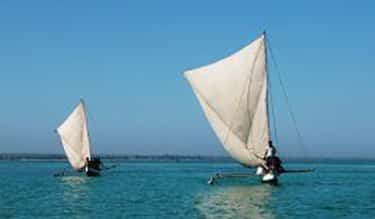Vezo are nomadic fishermen, their territory extends from Morondava (border Sakalava north) to Toliara, They live mainly in fishery products, they sell or barter against other commodities. They are hardy fishermen, but many sedentary and reduce their ancestral tradition. It is said that the Vezo women are the most beautiful women in Madagascar.
From Toliara to Morombe, the second greatest barrier reef along the coast, more than two hundred and fifty kilometers. It is essentially on this coastal strip that live Vezo. sailors, they use an outrigger canoe which allows them to reach the reef. They live in symbiosis with the large lagoon. The fishing techniques and materials, remained traditional although sometimes the nylon net replaced the compound baobab fiber, weighted shells. the harpoon, spear and net fishing are the main instruments.
Once the catch brought ashore, fish is usually dried in the sun, salted and smoked to be stored for weeks. It may be sold or exchanged against salt, fabrics, oil and other products.
nomads, the "Vezo" roam the west coast during the dry season (about 4 months a year) looking for more fish sites and follow some particular species of fish such as yellowfin tuna, which is popular, Migration season, their camp is limited to the simplest way : some "tents sail", made from webs of their canoes and wooden poles (masts…), when the wind rises, they spill their canoes and use it as a shelter. This technique is most often used when camping on deserted islands such as the islands in the West like Barennes ,Akoho or Satrana islands in the south.
Among the particular customs to Vezo, include fishing for sea turtle that follows a sacred ritual. Custom dictates that once the captured turtle, it is conveyed to the altar specially designed for its sacrifice. The meat is then shared between the male members of the group. This sharing is considered a duty to the will of the ancestors. Another specificity of the Vezo people is the lack of male circumcision as this custom is followed by almost all Malagasy. This could support the hypothesis that their ancestors come from an African strain after the Austronesian arrivals from South Asia -Is who instilled their manufacturing these boats so typical that they use to date. (view the photo). These types of canoes come from Austronesian design, not African. The use of the balance is very characteristic boats of Southeast Asia. In what circumstances, this culture is it passed Vezo, may be , we'll never know..

